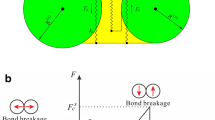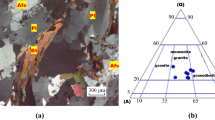Abstract
This study investigates the mechanical properties of rock material at the grain scale. A multilevel parallel bonded-grain based model (Multi Pb-GBM) is proposed to revel the microstructure of granite. The bonded modes of the samples are classified into three types: intra-grain contacts, inter-grain contacts between the same type of mineral, and inter-grain contacts between two different minerals. The parameters of the model are obtained from calculation tests of the uniaxial compressive strength and the Brazilian tension strength. Then, comprehensive simulations are conducted to examine the dynamic damage evolution of brittle granitic rock. The impact of the mineral distribution mode and the grain size coefficient on the simulated failure mode and rock strength are examined. An intact fracture-monitored system is established based on the fish function, and the behaviors of the microfractures are discussed. The results indicate that Multi Pb-GBM can effectively simulate rock mechanical problems and that it has advantages when simulating typical crystalline rocks.


















Similar content being viewed by others
References
Akesson U, Hansson J, Stigh J (2004) Characterisation of microcracks in the Bohus granite, western Sweden, caused by uniaxial cyclic loading. Eng Geol 72(1–2):131–142
Bewick RP, Kaiser PK, Bawden WF, Bahrani N (2014) DEM simulation of direct shear: 1. Rupture under constant normal stress boundary conditions. Rock Mech Rock Eng 47:1647–1671
Bahrani N, Kaiser PK, Valley B (2014) Distinct element method simulation of an analogue for a highly interlocked, non-persistently jointed rockmass. Int J Rock Mech Min Sci 71:117–130
Brace WF, Paulding B, Scholz C (1966) Dilatancy in the fracture of crystalline rocks. J Geophys Res 71:3939–3953
Cai M (2010) Practical estimates of tensile strength and Hoek-Brown strength parameter mi of brittle rocks. Rock Mech Rock Eng 43:167–184
Cho N, Martin CD, Sego DC (2007) A clumped particle model for rock. Int J Rock Mech Min Sci 44(7):997–1010
Cundall PA, Strack ODL (1980) Discussion: a discrete numerical model for granular assemblies. Geotech 30(3):331–336
Eberhardt E, Stead D, Stimpson B, Read RS (1998) Identifying crack initiation and propagation thresholds in brittle rock. Can Geotech J 35(2):222–233
Erarslan N, Williams DJ (2012) Investigating the effect of cyclic loading on the indirect tensile strength of rocks. Rock Mech Rock Eng 45(3):327–340
Fakhimi A, Villegas T (2007) Application of dimensional analysis in calibration of a discrete element model for rock deformation and fracture. Rock Mech Rock Eng 40(2):193–211
Gao F, Stead D, Elmo D (2016) Numerical simulation of microstructure of brittle rock using a grain-breakable distinct element grain-based model. Comput and Geotech 78(Sep.):203–217
Han ZH, Zhang LQ, Zhou J (2019) Uniaxial compression test and numerical studies of grain size effect on mechanical properties of granite. J Eng Geol 27(3):497–504
Hofmann H, Babadagli T, Zimmermann G (2015) A grain based modeling study of fracture branching during compression tests in granites. Int J Rock Mech Min Sci 77:152–162
Hu XJ, Bian K, Liu J (2019) Coupled flow network and discrete element modeling of injection-induced crack propagation and coalescence in brittle rock. Chin J Rock Mech Eng 38(10):2069–2083
Huang YH, Yang SQ, Ranjith PG et al (2017) Strength failure behavior and crack evolution mechanism of granite containing pre-existing non-coplanar holes:experimental study and particle flow modeling. Comput Geotech 88(1):182–198
Lambert C, Coll C (2014) Discrete modeling of rock joints with a smooth-joint contact model. J Rock Mech Geotech Eng 6(1):1–12
Lajtai EZ, Lajtai VN (1974) The evolution of brittle fracture in rocks. J Geolog Soc 130(1):1–16
Lan HX, Martin CD, Hu B (2010) Effect of heterogeneity of brittle rock on micromechanical extensile behavior during compression loading. J Geophys Res Solid Earth. 115 (B1)
Li XF, Zhang QB, Li HB (2018) Grain-based discrete element method(GB-DEM) modelling of multiscale fracturing in rocks under dynamic loading. Rock Mech Rock Eng 51(12):3785–3 817
Liu G, Cai M, Huang M (2018) Mechanical properties of brittle rock governed by micro-geometric heterogeneity. Comput and Geotech 104:358–372
Martin CD, Chandler NA (1994) The progressive fracture of Lac du Bonnet granite. Int J Rock Mech Min Sci Geomech Abstr 31(6):643–659
Mahabadi OK, Tatone BSA, Grasselli G (2014) Influence of microscale heterogeneity and microstructure on the tensile behavior of crystalline rocks. J Geophys Res-Sol Ea 119(7):5324–5341
Merriam R, Rieke HH, Kim YC (1970) Tensile strength related to mineralogy and texture of some granitic rocks. Eng Geol 4:155–160
Mehranpour MH, Kulatilake PHSW (2017) Improvements for the smooth joint contact model of the particle flow code and its applications. Comput and Geotech 87:163–177
Morgan SP, Johnson CA, Einstein HH (2013) Cracking processes in Barre granite: fracture process zones and crack coalescence. Int J Fracture 180(2):177–204
Munjiza A (2004) The combined finite-discrete element method. John Wiley, Chichester, West Sussex, U. K.
Peng J, Wong LN, TEH CI (2017) Influence of grain size heterogeneity on strength and microcracking behavior of crystalline rocks. J Geophys Res-Sol Ea 122(2):1054–1073
Peng J, Wong LN, Teh CI, Li Z (2018) Modeling micro-cracking behavior of Bukit Timah granite using grain-based model. Rock Mech Rock Eng 51(1):135–154. https://doi.org/10.1007/s00603-017-1316-x
Peng S, Johnson AM (1972) Crack growth and faulting in cylindrical specimens of chelmsford granite. Int J Rock Mech Min Sci Geomech Abstr 9(1), 37–86
Potyondy DO (2010) A grain-based model for rock:approaching the true microstructure. Proceedings of the Rock Mechanics in the Nordic Countries. Kongsberg,Norway: Norwegian Group for Rock Mechanics. 225–234
Potyondy DO, Cundall PA (2004) A bonded-particle model for rock. Int J Rock Mech Min Sci 41:1329–1364
Qi SW, Lan HX, Martin D et al (2019) Factors controlling the difference in Brazilian and direct tensile strengths of the Lac Du bonnet granite. Rock Mech Rock Eng 53:1005–1019. https://doi.org/10.1007/s00603-019-01946-x
Sajid M, Coggan J, Arif M, Andersen J, Rollinson G (2016) Petrographic features as an effective indicator for the variation in strength of granites. Eng Geol 202:44–54
Sousa LMO (2013) The influence of the characteristics of quartz and mineral deterioration on the strength of granitic dimensional stones. Environ Earth Sci 69:1333–1346
Tapponnier P, Brace WF (1976) Development of stress-induced microcracks in Westerly Granite. Int J Rock Mech Min Sci Geomech Abstr 13(4):103–112
Tullis J, Yund RA (1977) Experimental deformation of dry westerly granite. J Geophys Res 82(36):5705–5718
Weng MC, Li HH (2012) Relationship between the deformation characteristics and microscopic properties of sandstone explored by the bonded-particle model. Int J Rock Mech Min Sci 56:34–43
Wong RHC, Chau KT, Wang P (1996) Microcracking and grain size effect in Yuen Long marbles. Int J Rock Mech Min Sci Geomech Abstr 33(5):479–485
Yilmaz NG, Karaca Z, Goktan RM, Akal C (2009) Relative brittleness characterization of some selected granitic building stones: influence of mineral grain size. Constr Build Mater 23:370–375
Yoon J (2007) Application of experimental design and optimization to PFC model calibration in uniaxial compression simulation. Int J Rock Mech Min Sci 44(6):871–889
Zhai MG, Zhang Q, Chen GN (2016) Adventure on the research of continental evolution and related granite geochemistry. Chin Sci Bull 61(13):31–37
Zhang YH, Wong LNY (2019) An extended grain-based model accounting for microstructures in rock deformation. J Geophys Res-Sol Ea 124(1):125–148
Zhou J, Zhang LQ, Yang DX (2017) Investigation of the quasi-brittle failure of Alashan granite viewed from laboratory experiments and grain-based discrete element modeling. Materials 10(7):835
Zou C, Wong LN (2014) Experimental studies on cracking processes and failure in marble under dynamic loading. Eng Geol 173:19–31
Acknowledgements
The research received support from the National Natural Science Foundation of China (Grant Nos. 42072305 and 41831293). We appreciate the kind support. Besides, we also thank Zhiwen Wang and Xueliang Duan for their contributions to this paper.
Funding
The research received support from the National Natural Science Foundation of China (Grant Nos. 42072305 and 41831293).
Author information
Authors and Affiliations
Contributions
First author conducted design of study, analysis of data, drafting and revision of the manuscript. Second author was responsible for numerical methodology and the code of persistent homology analysis. Third author and fourth author provided the funding acquisition and project administration, information, and analysis. All authors gave their final approval of the manuscript version to be submitted.
Corresponding author
Ethics declarations
Conflict of interest
The authors declare no competing interests.
Rights and permissions
Springer Nature or its licensor holds exclusive rights to this article under a publishing agreement with the author(s) or other rightsholder(s); author self-archiving of the accepted manuscript version of this article is solely governed by the terms of such publishing agreement and applicable law.
About this article
Cite this article
Li, G., Liu, S.Q., Ma, F.S. et al. A multilevel parallel bonded-grain based model (Multi Pb-GBM) accounting for microstructure failures of typical crystalline rocks. Bull Eng Geol Environ 81, 475 (2022). https://doi.org/10.1007/s10064-022-02976-6
Received:
Accepted:
Published:
DOI: https://doi.org/10.1007/s10064-022-02976-6




